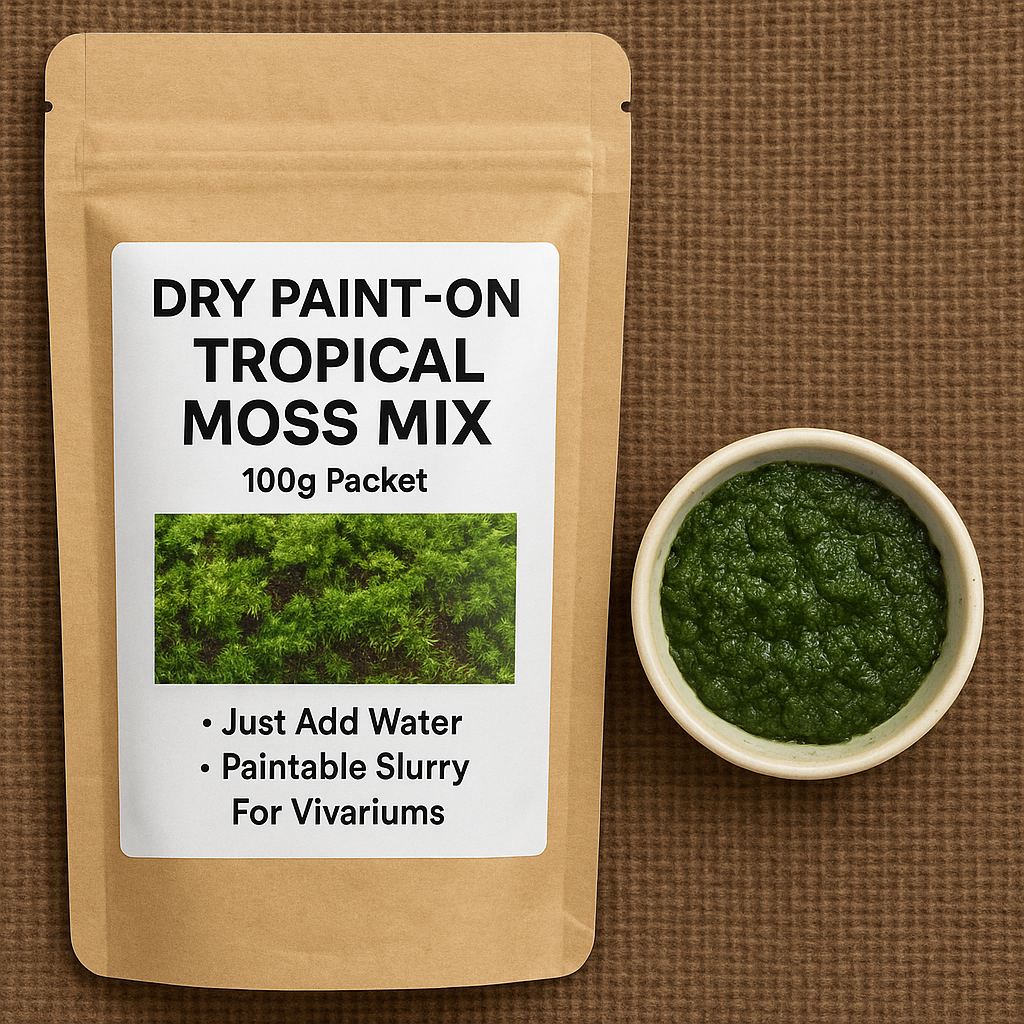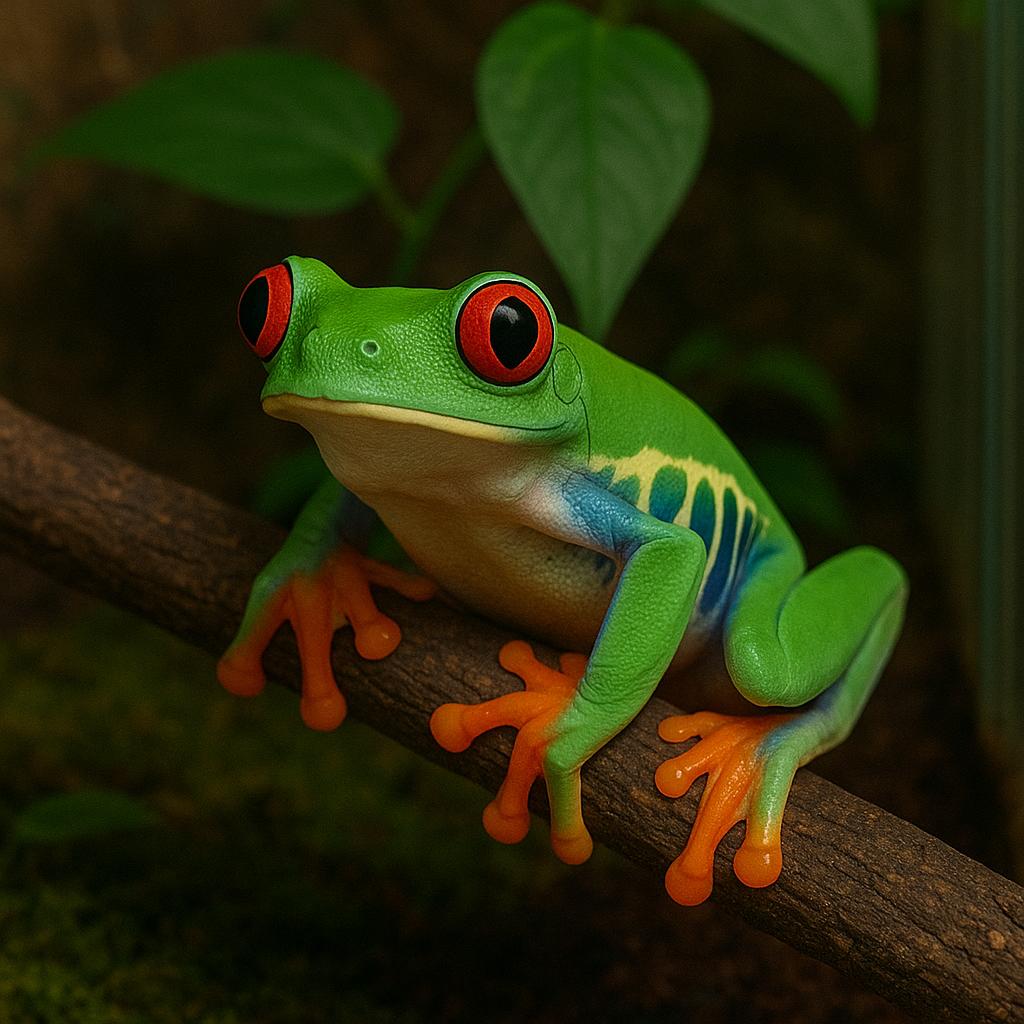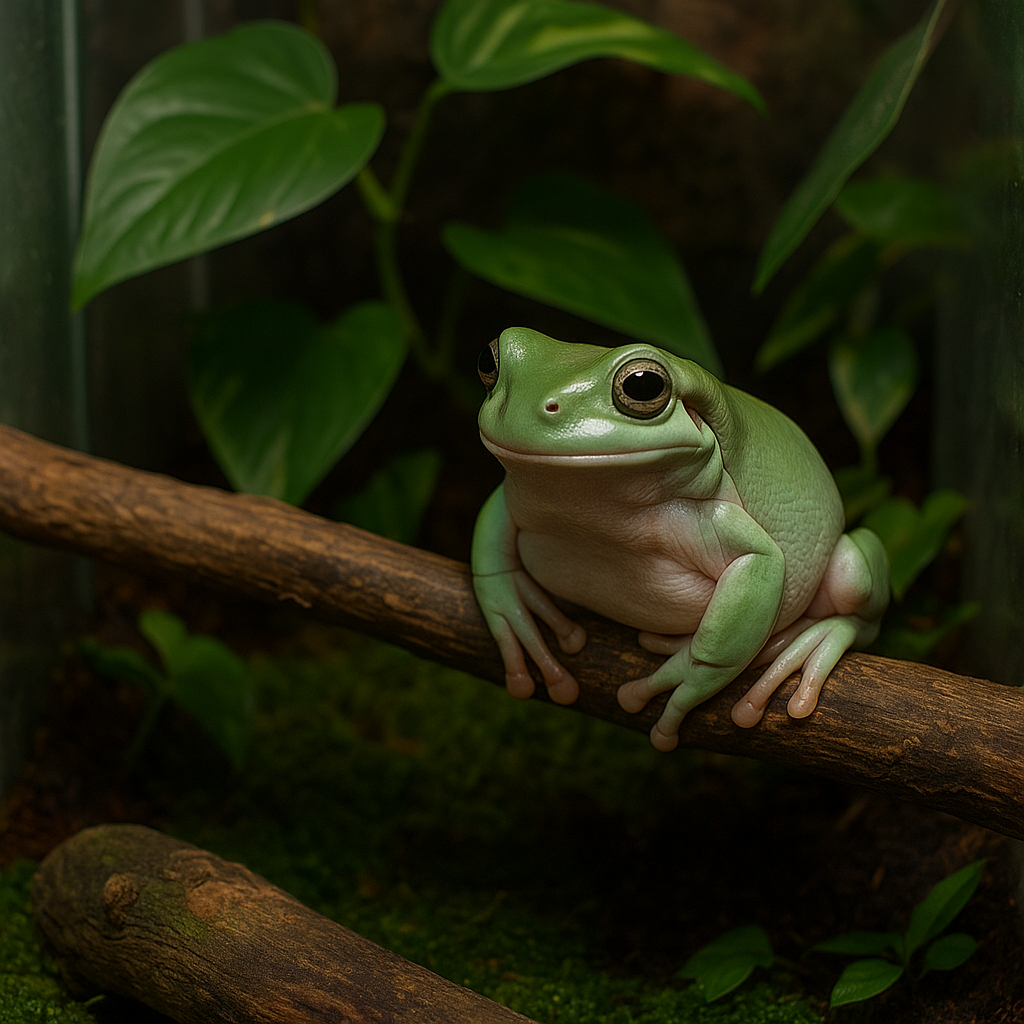Moss is one of the most transformative elements you can add to a dart frog vivarium. A bare background can look artificial and flat, but with moss it turns into a living wall of greenery, rich with texture and natural charm. Beyond its aesthetic value, tropical moss contributes to humidity regulation, microbiome stability, and the overall health of your frogs and plants. In this guide, we’ll explore how to grow moss in a vivarium, comparing fast methods like paint-on moss slurry with slower but rewarding approaches such as tree fern panels. We’ll also cover aftercare, troubleshooting, and how to use our convenient dry paint-on moss mix for quick results.
Why Tropical Moss Is Essential in a Vivarium
Moss isn’t just a decorative flourish — it’s a living part of the ecosystem. Here’s why it deserves a place in every dart frog enclosure:
- Visual richness: Tropical moss comes in many shades of green, from bright lime to deep emerald. Mixing species creates depth and natural variation, preventing a flat or artificial look.
- Humidity buffering: Moss soaks up water and gradually releases it, maintaining stable moisture levels that amphibians rely on.
- Microbiome support: Moss is home to beneficial bacteria, fungi, and microfauna that help recycle nutrients and keep waste under control.
- Animal interaction: Dart frogs use moss to hide, perch, and even deposit eggs. A mossy vivarium more closely mirrors their natural environment.
The Fast Method: Moss Slurry and Paint-On Mix
For those who want rapid coverage on backgrounds, cork, or hardscape, a moss slurry (also called moss paint) is the go-to technique. Here’s how it works:
1. Collecting Tropical Moss
Gather a mix of tropical mosses from existing vivariums or cultures. Diversity matters — different species thrive under different microclimates, so combining them increases the chance of success. Even tiny scraps will regenerate under the right conditions.
2. Adding Sphagnum Moss
Sphagnum is invaluable in a moss slurry. It binds the mixture, holds water, and helps fragments stick to vertical surfaces. It also boosts long-term moisture retention.
3. Blending into Slurry
Use a dedicated blender to combine tropical moss, sphagnum, and a splash of water until you achieve a thick, yoghurt-like texture. Too thin and it will drip off; too thick and it won’t spread evenly.
4. Painting the Background
With a brush, spatula, or gloved hand, apply the slurry to your vivarium background. Porous materials such as cork bark, tree fern panels, and foam work best. Mist regularly and keep humidity high — new green shoots often appear in as little as four weeks.
5. Drying for Later Use
Excess slurry can be air-dried into flakes and stored. Later, simply rehydrate with water to use again. For convenience, you can skip the DIY and buy ready-made dry paint-on moss mix, which works exactly the same way.
The Slow Method: Tree Fern Panels
If slurry is the quick fix, tree fern panels are the patient keeper’s choice. These fibrous boards, made from tropical tree fern trunks, are naturally spore-rich and create an ideal substrate for moss and epiphytes. The advantages include:
- Spore germination: Many panels contain dormant moss and fern spores that slowly awaken in high humidity.
- Natural structure: Their porous texture allows roots and rhizoids to grip securely.
- Durability: Panels last for years and support orchids, bromeliads, and ferns as well as moss.
The trade-off is time. It can take months or even a year before moss becomes established. At first, the panel may appear bare, but with consistent misting, faint green patches emerge and spread. For best results, I combine both methods: slurry for fast cover and tree fern panels for long-term growth.
Caring for Moss in a Vivarium
Once moss is applied, the real work begins. To thrive, it needs stable conditions:
| Factor | Recommendation |
|---|---|
| Humidity | 70–90%, with consistent misting. |
| Lighting | Bright but indirect. Full-spectrum LED vivarium lights are ideal. |
| Water | Always use dechlorinated or rainwater to avoid chemical burn. |
| Airflow | Gentle circulation to prevent mould, but not so strong it dries moss out. |
| Temperature | 24–28°C suits most tropical mosses and dart frog setups. |
Common Problems and Fixes
- Moss turning brown: Usually due to dryness. Increase misting and check water quality.
- Algae overgrowth: Reduce light intensity or duration, and improve airflow.
- Mould patches: Improve ventilation and add springtails to outcompete mould.
- No visible growth: Be patient. Moss often establishes invisibly before greening up.
Pairing with Dry Paint-On Moss Mix
For convenience, our dry paint-on moss mix provides the same results as homemade slurry, without the mess. Each packet can be rehydrated with water, creating a brushable paste that spreads easily onto backgrounds and wood. It’s perfect for new vivarium builds or for refreshing old enclosures where moss has thinned out.
Conclusion
Learning how to grow tropical moss in a vivarium is one of the most rewarding parts of building a bioactive dart frog enclosure. Moss adds vibrancy, stabilises humidity, and supports the invisible web of microbes and microfauna that keep your setup healthy. Whether you prefer the fast coverage of a slurry, the slow emergence of tree fern panels, or the simplicity of a dry paint-on moss mix, the result is the same: a living, breathing background that looks like a slice of rainforest brought indoors.
Image Suggestions
- Image 1: Moss slurry being brushed onto cork bark. Alt text: “Applying tropical moss slurry onto vivarium background for dart frogs.”
- Image 2: A tree fern panel showing early green moss patches. Alt text: “Tree fern panel with tropical moss beginning to grow in a vivarium.”
- Image 3: Lush moss carpet established on vivarium background. Alt text: “Fully grown tropical moss covering vivarium background.”
- Image 4: Packet of dry paint-on moss mix beside a small dish of rehydrated slurry. Alt text: “Dry paint-on moss mix rehydrated for use in tropical vivarium.”



